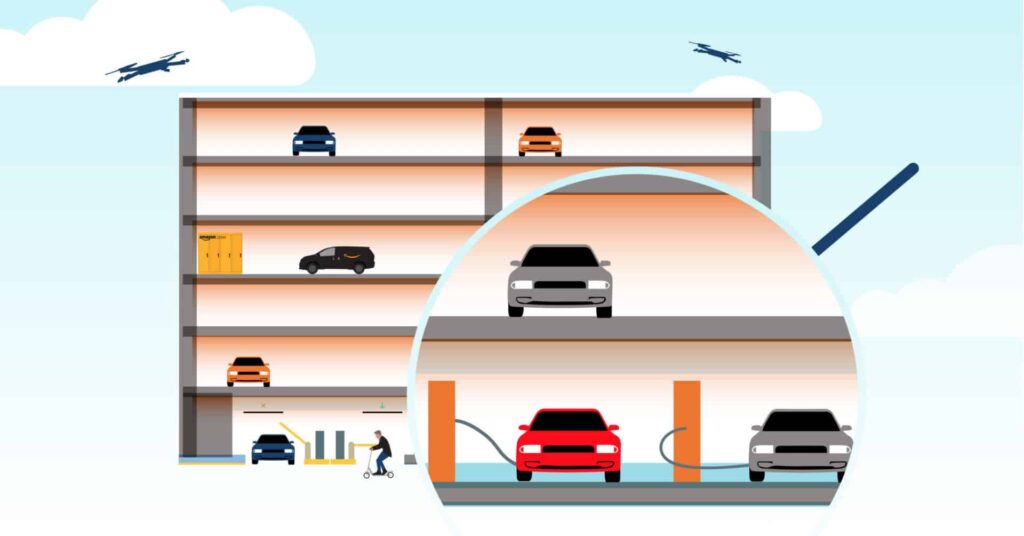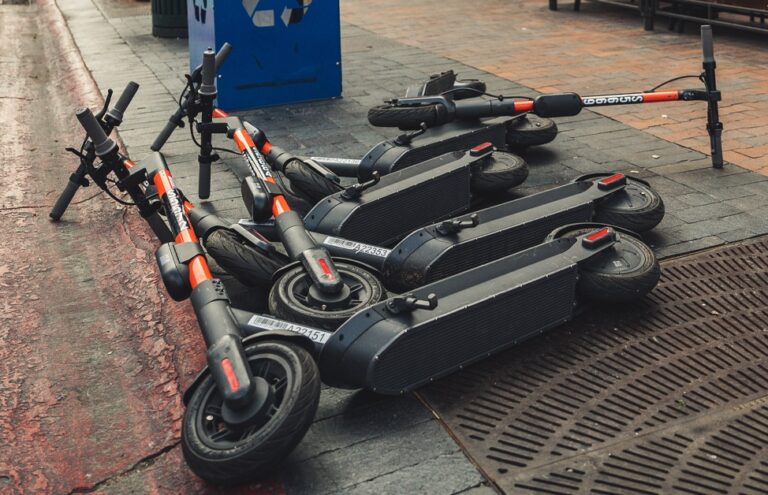Micromobilty has become a fixture of the urban ecosystem. But the often dockless nature of these scooters and bikes has become a point of contention among city officials and urban dwellers.
If you live in a city with eScooters, the sight of devices strewn across sidewalks, in streets, even floating in lakes or dangling off buildings is likely a familiar sight. Though comedic at times, managing the whereabouts of these free-roaming devices has posed a serious challenge that threatens their survival.
We think the mobility hub can be a solution.

The Charging Challenge
Many eScooter companies have turned to the gig economy for charging, paying contracted workers between $5 and $20 to recharge dockless devices. This increasingly competitive—and sometimes hostile—practice doesn’t appear very sustainable; profits for chargers are inconsistent and their transportation vehicles are further contributing to congestion. In light of these downsides, some other scooter services are turning to battery swapping, although this practice restricts range and requires backstock of batteries.
There is another alternative: docking and charging stations for scooters.

The COVID Context
With consumers seeking more isolated and hygienic ways to get around, micromobility has stepped into the limelight as a viable alternative to public transportation.
New ridership has more than doubled with those new users sticking around 93% more often than they did before the pandemic and it appears that they’re using rides for longer trips (Bird).
Clear trends in micromobility use that we were already starting to see pre-pandemic have simply been accelerated by COVID-19. And they’re not expected to slow down in a post-pandemic world.

A Smart Approach
Mobility hub concepts can start to capitalize on these trends now. Picture this: rather than discarding scooters anywhere, riders are asked to return their device to the location where it was picked up. In return, these consumers will pay a fixed rate to have a scooter they can call their own for a few hours.
It’s a marginally different model than what exists today, but for the growing use cases for the eScooter – commuting, sightseeing, or for a casual outing – it makes sense. The need to find a scooter anywhere is eliminated, because your scooter will be right where you left it. Meanwhile, the burden of harboring scooters will be removed from our sidewalks and transferred to more concealed and protected parking garages. This means a longer life for scooters and less waste in the environment.
With a smart parking solution, all of this is possible. We can see how it plays into smart city ideals: more sustainable practice for our scooters, our sidewalks, and our streets…but what does it mean for you?
Relevance – Using your parking garage as an asset only for cars is limiting; and as cars potentially fade in relevance or other modes of mobility surge, you risk becoming obsolete. Elevating your smart parking system with mobility offerings anchors you an evolving ecosystem. Regardless of which mode consumers choose for their journey, your asset remains relevant to them.
Riders – Bringing consumers into your garage, whether it’s when they’re docking a scooter or getting out of their car, is an opportunity to deliver more value. Drivers who have just parked and have a few blocks left to their destination are presented with a fleet of scooters to take instead. In the process, they can be exposed to advertisements and other services like car washes. Once they’re inside, the opportunities to offer more value to your customers are boundless.
Revenue – At the end of the day, providing these added value services is just another way to generate revenue from the people and businesses using your garage.
And just like that, the future of parking will no longer just park cars. Parking assets. Mobility hubs will park cars, scooters, and anything else that will keep your asset relevant, your riders happy, and revenue diversified.
The Future Parks Here. And We’re Here to Guide You!
Receive a weekly email of our latest thought leadership articles penned by our own executives, academics, and other mobility leaders about the dynamic shift
of parking assets into mobility hubs.

